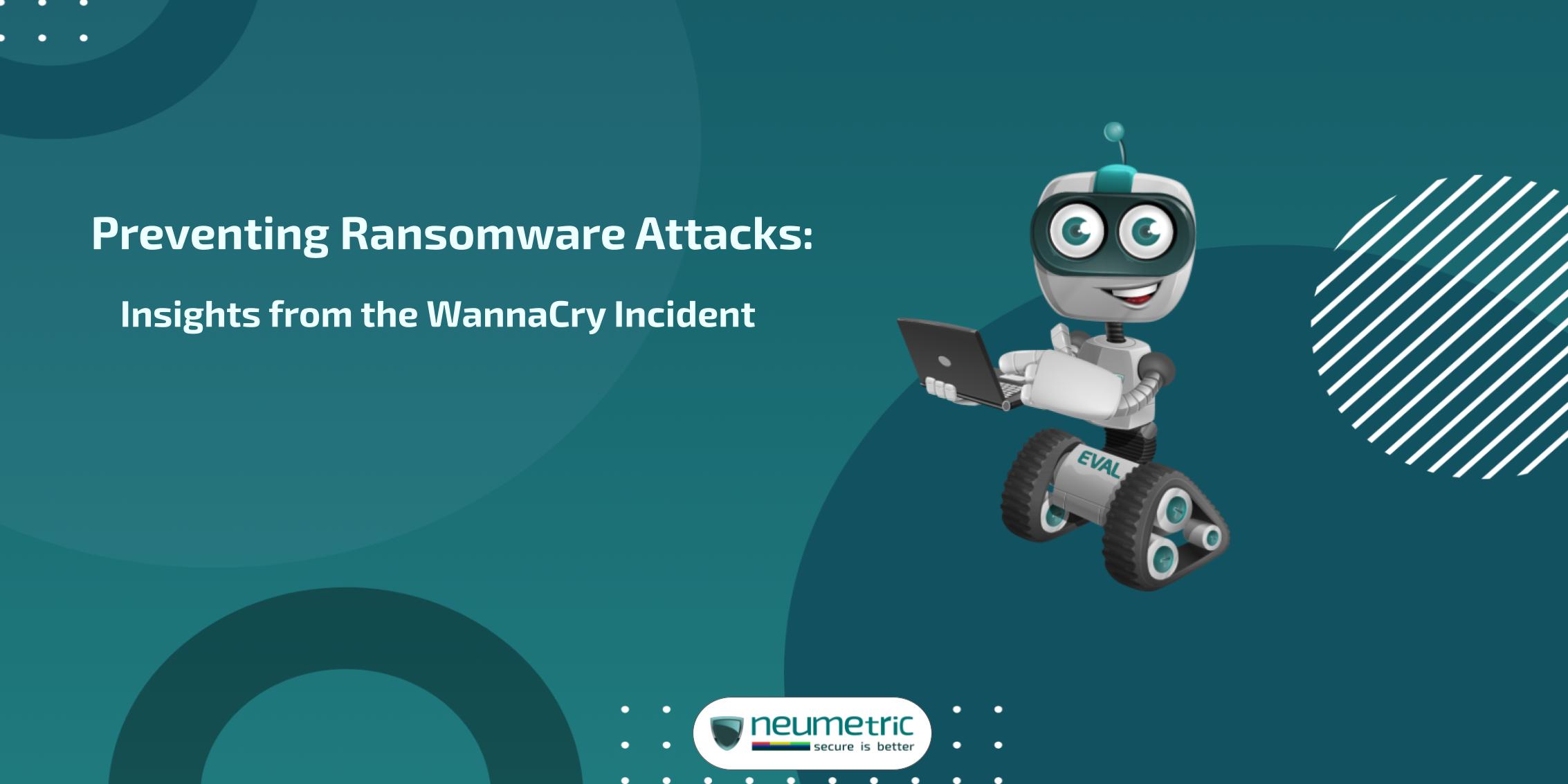Table of Contents
ToggleIntroduction
In recent years, cyber attacks have become more sophisticated & widespread, posing substantial problems to both enterprises & individuals. Ransomware has evolved as one of the most insidious & destructive types of cyberattack. Ransomware, unlike ordinary malware, encrypts crucial data & demands payment—often in cryptocurrency—before decrypting the files, thereby holding the victim’s data hostage. Ransomware attacks can have significant financial & operational effects, ranging from revenue & productivity losses to permanent reputational harm.
The WannaCry ransomware assault in May 2017 serves as a harsh reminder of the destruction that ransomware can do on a worldwide scale. WannaCry, which targeted computers running Microsoft Windows operating systems, spread quickly across 150 countries, infecting more than two hundred thousand (200,000) devices in just days. The attack disrupted critical services, including healthcare systems in the United Kingdom [UK] & logistics companies worldwide, highlighting vulnerabilities in both public & private sector organizations.
Understanding the processes & consequences of ransomware attacks is critical for a number of reasons. The first priority is to preserve sensitive data & ensure operational continuity for businesses & organizations. As ransomware evolves, attackers fine-tune their strategies, taking advantage of software & human behavior flaws. Furthermore, the financial incentives behind ransomware assaults make them a chronic danger that necessitates preemptive measures & strong defenses.
Understanding Ransomware Attacks
Ransomware is a sort of malicious software [malware] that prevents access to a computer system or data unless a ransom is paid. It often encrypts files on the victim’s machine with strong encryption techniques, rendering them inaccessible without the attacker’s decryption key. Ransom requests frequently include bitcoin payment in order to anonymize transactions & make tracking difficult for law enforcement.
Characteristics of ransomware
File Encryption: Ransomware often encrypts files on the victim’s computer or network with strong encryption methods (such as AES-256). This makes the files unavailable without the decryption key, which the attacker has.
Ransom Demands: After encrypting the files, ransomware shows a ransom letter requesting money (often in cryptocurrency) in exchange for the decryption key. The ransom sum varies widely & payment deadlines may be imposed to put more pressure on the victim.
Payment Anonymity: Because of their pseudonymous character, cryptocurrencies such as Bitcoin are frequently used for ransom payments, making it impossible to track transactions & identify culprits.
User Interface for Payment: Many ransomware strains provide a user-friendly interface for victims to navigate payment instructions & decryption processes, making transactions easier for the attacker.
Common Methods of Ransomware Deployment
Phishing Emails: Phishing is still one of the most common methods for transmitting ransomware. Attackers use fraudulent emails that impersonate reputable businesses or include urgent messages to deceive recipients into clicking on harmful links or downloading infected attachments. Ransomware begins to execute on the victim’s device after being clicked or downloaded.
Malicious Attachments: Ransomware can be placed in email attachments like Microsoft Office documents (e.g., Word, Excel) or ZIP files. When opened, these attachments may exploit software vulnerabilities to launch ransomware, requiring users to allow macros or scripts that start the infection process.
Social Engineering Tactics: Beyond phishing emails, ransomware operators use a variety of social engineering techniques to confuse victims. This includes impersonating trusted entities, creating urgency (e.g., bogus security alerts) & duping victims into revealing critical information or carrying out destructive acts.
Exploit Kits: Exploit kits are pre-packaged software programs that exploit known vulnerabilities in software applications or operating systems. When a victim visits a hacked website or clicks on a malicious link, the exploit kit automatically finds & exploits vulnerabilities to download & install ransomware on the victim’s computer.
Impact of Ransomware Attacks on Organizations
Financial Losses: Organizations may face direct financial losses if they pay the ransom requested by attackers. The quantity demanded varies greatly depending on the size & type of the organization. Operational costs include crisis response, cleanup efforts, legal fees & regulatory fines, in addition to ransom payments. Ransomware attacks can disrupt business operations, causing significant downtime while systems are recovered. This downtime leads to lost income opportunities & diminished productivity.
Data Loss & Recovery: Ransomware encrypts sensitive information, rendering it inaccessible until the ransom is paid or alternate recovery methods are performed. In order to restore encrypted data & minimize operational disturbance, organizations may need to invest in sophisticated backup & recovery systems.
Reputational Damage: The public exposure of a ransomware attack can harm an organization’s brand, undermining customer confidence & loyalty. Shareholders & investors may see a ransomware assault as a sign of insufficient cybersecurity safeguards, affecting stock prices & overall financial health.
WannaCry Incident
The WannaCry ransomware assault, which happened in May 2017, is notable as one of the most major & extensive cyberattacks in recent memory. It targeted machines running Microsoft Windows by exploiting EternalBlue, a weakness in the Server Message Block [SMB] protocol. EternalBlue, created by the United States National Security Agency [NSA] & stolen by the hacking group Shadow Brokers, enabled WannaCry to spread quickly across networks by attacking unpatched systems.
WannaCry encrypted files on afflicted machines & demanded Bitcoin payments to decrypt them. The attack employed sophisticated encryption algorithms, making data retrieval without the decryption key nearly impossible. It affected nearly two hundred thousand (200,000) machines in more than one hundred & fifty (150) nations within days of its inception, impacting numerous sectors such as healthcare, logistics & government institutions.
Timeline of Events & Affected Entities
Initial Outbreak: WannaCry ransomware is initially spotted & spreads quickly across networks globally. The assault primarily targets computers running Microsoft Windows operating systems that have not received the MS17-010 patch, which fixes the EternalBlue vulnerability.
Global Spread: WannaCry attacks tens of thousands of systems across more than one hundred & fifty (150) countries. The attack spreads swiftly through susceptible internet-connected systems & internal networks of large corporations & institutions.
Impact on Healthcare: Hospitals & healthcare institutions in the UK, notably those run by the National Health Service [NHS], are badly impacted. Patient records become inaccessible, resulting in appointment cancellations & medical service disruptions.
Logistics & Manufacturing: Companies in the logistics & manufacturing sectors encountered operational disruptions as ransomware encrypted critical data & hampered supply chain operations.
Government Agencies: Government agencies around the world, including state & local governments, were affected, limiting their capacity to provide public services & preserve operational continuity.
Analysis of WannaCry’s Propagation Techniques (EternalBlue Exploit)
EternalBlue, initially designed by the NSA, took advantage of a significant hole (CVE-2017-0144) in the SMB protocol implementation of older versions of Microsoft Windows. This flaw enabled remote attackers to execute arbitrary code on affected systems without requiring any user input. By sending specially crafted packets to the SMBv1 server, EternalBlue caused a buffer overflow, allowing attackers to obtain unauthorized access & control of the target machine. This feature was critical for WannaCry’s initial attack vector since it gave a footing in networks that had not installed the requisite security upgrades.
When a system was hacked by EternalBlue, WannaCry used a variety of aggressive spreading strategies to expand its reach. One significant strategy was network scanning, in which the ransomware actively sought out more vulnerable PCs on the same network segment or accessible via SMB ports (TCP ports 139 & 445). This scanning capabilities enabled WannaCry to quickly move across local networks & beyond, infecting associated computers & magnifying the attack’s magnitude in a short amount of time.
WannaCry’s automated & self-propagating nature had a tremendous worldwide impact. Within hours of its release, WannaCry threatened essential infrastructure such as healthcare systems, government organizations, financial institutions & telecommunications networks. This quick spread was unprecedented, highlighting the vulnerability of enterprises around the world to cyber assaults that exploit known weaknesses in widely used software.
The impact of WannaCry’s spread was profound. In the healthcare sector, multiple hospitals & clinics, particularly those run by the NHS in the United Kingdom, experienced serious disruptions as medical records became inaccessible, resulting in canceled appointments, delayed treatments & compromised patient care. Government agencies encountered operational issues, with some unable to provide key services or handle public inquiries owing to encrypted networks. The banking sector also felt the effects, albeit to a lesser scale, with concerns about data security & potential interruptions to financial operations & services.
In response to the WannaCry assault, Microsoft released emergency security fixes (MS17-010) to address the EternalBlue vulnerability in compatible Windows versions. This reaction emphasized the crucial need of timely patch management & proactive cybersecurity measures in protecting against known attacks. Furthermore, cybersecurity experts played a critical part in limiting the attack by detecting & triggering a kill-switch domain encoded in WannaCry’s code, temporarily halting its spread & giving firms time to fix susceptible systems.
Technical Analysis of WannaCry
How WannaCry Encrypted Files & Demanded Ransom
- Encryption Mechanism: When WannaCry infected a machine, it created a unique cryptographic key pair—a public key for encryption & a private key possessed by the attackers for decryption. It used the RSA-2048 encryption technique for asymmetric encryption, which meant that only the attackers could decrypt the files without the secret key.
- File Encryption: WannaCry encrypted a variety of file types, including documents, pictures, databases & others, utilizing sophisticated encryption methods such as AES-128. Each file was encrypted with a randomly generated symmetric key, which was then encrypted with the attacker’s public RSA key.
- Ransom Note: After encrypting files, WannaCry showed a ransom note on the victim’s computer, usually demanding Bitcoin payment to a specific cryptocurrency wallet. The ransom note provided instructions on how to make the payment & often included a countdown timer to increase urgency.
Vulnerabilities Exploited by WannaCry
- EternalBlue (CVE-2017-0144): This major vulnerability in Windows’ SMBv1 protocol enabled remote code execution on susceptible systems. EternalBlue allowed WannaCry to spread across networks by infecting unpatched Windows systems, even those running unsupported versions such as Windows XP.
- DoublePulsar: WannaCry also used the DoublePulsar backdoor implant, which was installed via EternalBlue. DoublePulsar allowed persistent access to affected devices, allowing attackers to run arbitrary instructions remotely & install ransomware payloads.
- SMB Protocol: The reliance on SMB protocol vulnerabilities underlined the need for timely patching & network segmentation to reduce the risk of lateral movement within enterprises’ networks.
Response Strategies During & After the Attack
- Emergency Patches: Microsoft issued an emergency security fix to address the EternalBlue vulnerability shortly after the WannaCry outbreak. Organizations were asked to install these patches right away to avoid future infections.
- Kill-Switch Activation: Security researchers found a kill-switch domain in WannaCry’s code. By registering this domain, they were able to temporarily halt the ransomware’s spread & give enterprises time to fix vulnerable systems.
- Incident Response Plans: Organizations established incident response teams to identify & isolate compromised systems, minimize operational disruptions, & when possible, restore services from backups.
- Communication & Coordination: Government agencies, law enforcement & cybersecurity organizations worked together globally to exchange threat intelligence, coordinate responses & aid affected entities with recovery operations.
Preventive Measures Against Ransomware Attacks
Ransomware attacks such as WannaCry have highlighted the essential need of proactive cybersecurity measures in mitigating risks & protecting organizations & individuals from catastrophic data breaches & financial losses.
Importance of Cybersecurity Hygiene & Best Practices
- User Awareness & Training: Educating employees about phishing emails, suspicious links & safe browsing habits can help them avoid accidentally installing malware or giving important information to attackers.
- Strong Password rules: Enforcing strong password rules, such as regular password changes & Multi Factor Authentication [MFA], provides an extra layer of security against unwanted access.
- Software updates & patching: Applying security patches & upgrades to operating systems, software & firmware as soon as possible helps to prevent vulnerabilities used by ransomware, such as WannaCry’s EternalBlue exploit.
- Network segmentation: Restricting access based on user roles & responsibilities reduces the impact of ransomware spreading laterally throughout an organization’s infrastructure.
Implementing Effective Backup Strategies
- Regular Backups: By performing regular backups of essential data & systems, enterprises can restore encrypted or compromised files without having to pay ransom demands.
- Offline & Immutable Backups: Storing backups offline or in immutable storage solutions prevents ransomware from accessing & encrypting backup data, maintaining its integrity & recoverability.
- Testing Backups: Backup integrity & restoration methods are regularly tested to ensure their effectiveness in recovering data & systems in the event of a ransomware attack or other disaster.
- Backup Retention Strategy: Implementing a backup retention strategy guarantees that various versions of data are preserved over time, allowing enterprises to recover from ransomware attacks that may have gone undetected for a long time.
Patch Management & Vulnerability Remediation
- Automated Patching: Using automated patch management solutions ensures that security fixes are deployed on time across all devices & systems, reducing the window of exposure to known vulnerabilities.
- Vulnerability Scanning & Assessment: Regular vulnerability scans & assessments identify potential flaws in systems & applications, helping organizations to prioritize & address high-risk issues quickly.
- Risk-Based Prioritization: Prioritizing patch distribution based on risk assessment, severity ratings & potential impact on business operations allows resources to be allocated more effectively with the most significant vulnerabilities addressed first.
- Vendor Support & End-of-Life Systems: Maintaining vendor support & updating or retiring end-of-life systems that no longer receive security patches minimizes the risk of ransomware exploiting vulnerabilities.
Role of Endpoint Security Solutions & Firewalls
- Antivirus & Anti-Malware Software: Using effective antivirus & anti-malware solutions with real-time scanning capabilities aids in the detection & blocking of ransomware infestations before they can infect devices.
- Behavioral Analysis & Machine Learning [ML]: Advanced endpoint detection & response [EDR] solutions that employ behavioral analysis & machine learning algorithms can detect suspicious activity & potential ransomware behavior patterns.
- Firewall Configuration: Blocking unauthorized access & outgoing connections to malicious domains or IP addresses lowers the risk of ransomware communication & command-and-control [CnC] activities.
- Application Whitelisting: Enforcing application whitelisting policies that only allow permitted programs to execute on endpoints reduces the danger of ransomware execution by unauthorized or malicious software.
Enhancing Cybersecurity Posture
Improving cybersecurity posture entails implementing proactive ways to increase defenses, reduce risks & respond effectively to cyber threats.
Educating Employees & Users About Phishing & Social Engineering
- Phishing Awareness: Employees should be trained to spot phishing emails that try to trick recipients into providing personal information or installing malware. Training programs should focus on spotting suspicious email features such as unknown senders, urgent language & unexpected requests for personal or financial information.
- Social Engineering Awareness: Beyond emails, social engineering approaches use human psychology to trick people into disclosing sensitive information or doing actions that jeopardize security. Employees should be trained to recognize & respond to social engineering attempts through a variety of communication channels, such as phone calls, text messages & social media.
Conducting Regular Cybersecurity Audits & Risk Assessments
- Cybersecurity Audits: Cybersecurity audits compare the effectiveness of deployed security measures, policies & procedures to industry standards & regulations. They guarantee that security controls are correctly configured, monitored & maintained to protect against new threats & evolving attack vectors.
- Risk Assessments: Risk assessments help to detect potential threats, vulnerabilities & related hazards to corporate assets including data, systems & infrastructure. Organizations can effectively deploy resources to reinforce defenses by prioritizing mitigation activities based on likelihood & impact.
Incident Response Planning & Testing
- Incident Response Plan [IRP]: An Incident Response Plan [IRP] specifies the methods, roles & duties for identifying, responding to & recovering from security occurrences. It provides predetermined methods for determining the severity of the incident, containing the threat, minimizing damage & resuming normal operations.
- Tabletop Exercises & Simulations: Regular testing using tabletop exercises simulates real-world events to assess the IRP’s effectiveness, uncover gaps in response protocols & improve collaboration among incident response teams, IT workers & stakeholders.
Conclusion
The WannaCry ransomware outbreak in May 2017 was a watershed moment in cybersecurity, exposing weaknesses in global digital infrastructure & serving as a wake-up call to corporations, governments & individuals throughout the world. At its core, WannaCry encrypts files on compromised systems & demands Bitcoin ransom payments, taking advantage of the critical gap between vulnerability discovery & fix rollout. The impact was catastrophic, especially in industries such as healthcare, where hospitals saw disruptions in patient care as medical records became inaccessible. Government organizations, financial institutions & enterprises all suffered operational difficulties, demonstrating the widespread reach & indiscriminate nature of ransomware threats.
Key insights from the WannaCry outbreak highlight the significance of proactive cybersecurity measures. Effective patch management, which includes timely application of security updates, is critical for mitigating known vulnerabilities & reducing the attack surface for bad actors. Robust backup practices, including regular offline backups of sensitive data, ensure that enterprises can recover quickly without falling to ransomware.
Teaching employees about phishing scams & social engineering strategies is critical for strengthening the human component of cybersecurity defenses. Organizations can reduce the likelihood of successful ransomware infiltration by raising awareness & cultivating a culture of alertness among their employees.
WannaCry will have a long-term impact since it served as a catalyst for cybersecurity resilience & adaptation. As attacks evolve & become more complex, the lessons learnt from WannaCry require enterprises to be aware, adaptable & ready to protect against future ransomware & cyber threats with attention & resolve.
Frequently Asked Questions [FAQ]
What is ransomware?
Ransomware is malicious software that encrypts files on a victim’s computer & demands payment (usually in cryptocurrency) to decrypt them.
How does ransomware spread?
Ransomware often spreads through phishing emails, malicious attachments, compromised websites or exploiting vulnerabilities in software.
What preventive measures can organizations take against ransomware?
Organizations should implement regular software updates, maintain robust backups, educate employees about phishing & deploy endpoint protection with strong antivirus software.





